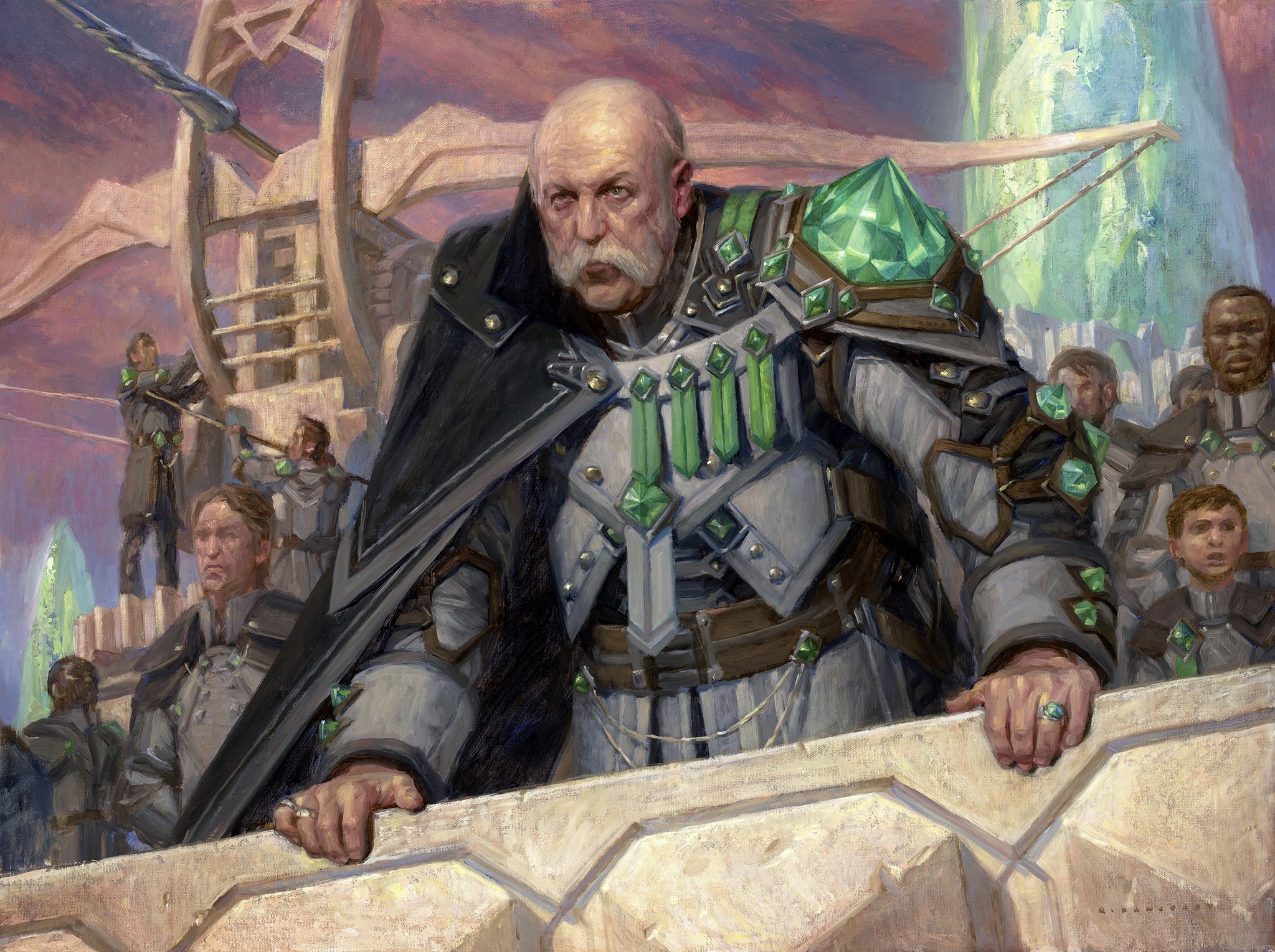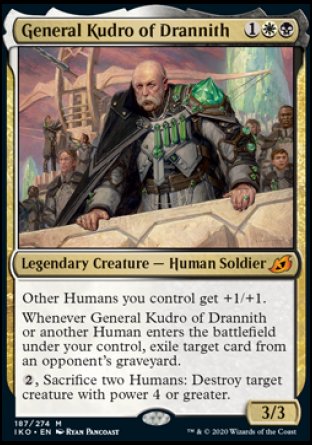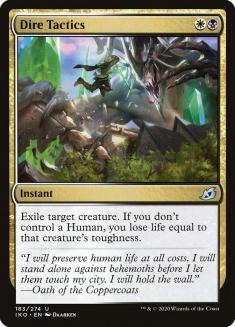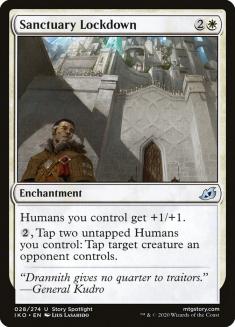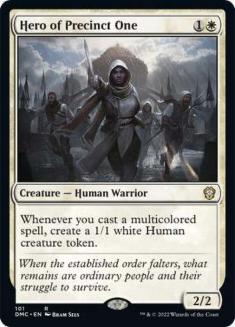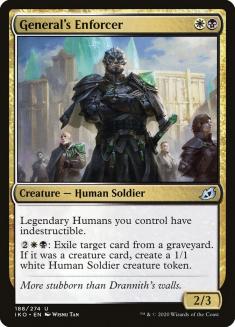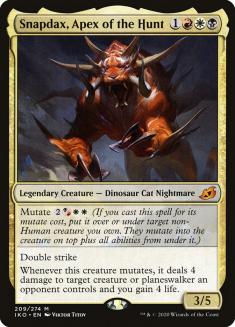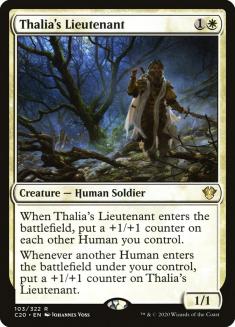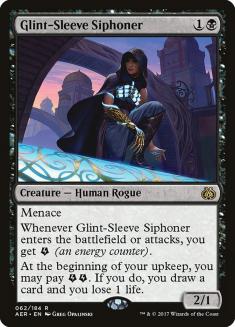We’re not even a week into the Ikoria: Lair of Behemoths preview season and I’ve gone back and forth on General Kudro of Drannith twice already. At first glance, I dismissed the card as a potential addition to the flex spots in Modern Humans and moved on to more exciting cards. When I came back to the card, my opinion of it soured even further, dismissing it even in such a minor role.
But the third time I looked at the card, and thought deeply about where it could shine, I started to see its potential. I’m still doubtful of its place in Modern Humans, the most obvious home for any reasonably powerful Human that costs three or less mana. But I think the card has great potential in both Standard and Pioneer.
The first realization that raised my opinion of General Kudro was just how many of the quality Knights in Standard are also Humans. There are more than enough to fill out a deck, and on top of that you still have access to Worthy Knight, a machine at pumping out 1/1 Human tokens to go wide, and now you have a card that pumps that army into a formidable force. The build is rather straightforward, building with all the best Human Knights available, with consideration for a good curve, but there’s a little spice at the end from Ikoria in the flex spots:
Creatures (33)
- 4 Knight of the Ebon Legion
- 4 Wintermoor Commander
- 4 Smitten Swordmaster
- 1 Order of Midnight
- 4 Venerable Knight
- 4 Worthy Knight
- 4 Blacklance Paragon
- 4 Acclaimed Contender
- 4 General Kudro of Drannith
Lands (22)
Spells (5)

This deck takes advantage of all three of General Kudo’s abilities quite well. Obviously pumping an army of Humans is the biggest draw, but in a format with escape, Cauldron Familiar, and Elspeth Conquers Death, the incidental graveyard hate is sure to pay dividends. Then you get to shoehorn removal into a deck that normally would have quite little because it needs a high creature count. With Worthy Knight you have fuel to sacrifice to that ability, letting you answer anything from Bonecrusher Giant to Cavaliers, and even contain Dream Trawler long enough to close the game.
Oftentimes, cards with lots of text disappoint because they can’t find a home where every one of its abilities is put to good use, leading to a situation where the card reads better than it plays. That isn’t the case here, and it gives me reason to believe General Kudro will play as well as or better than it reads.
The other help from Ikoria comes from the noncreature spells: Dire Tactics and Sanctuary Lockdown. Simply put, when you consistently have a Human on the battlefield, Dire Tactics is among the best removal spells in Standard. The exile clause is important against so many cards in Standard, from Cavalier of Flame to Uro, Titan of Nature’s Wrath to Midnight Reaper to Anax, Hardened in the Forge. To cover all those threats for a mere two mana is an excellent rate, and enough for me to include a removal spell in a maindeck that normally wouldn’t. It’s a second payoff for filling your deck with Humans, and I expect General Kudro and Dire Tactics to be best friends during their time in Standard.
Last we have Sanctuary Lockdown, a supplementary Anthem effect which, like General Kudro, synergizes nicely with Worthy Knight. The current Knights decks have underwhelmed in large part due to their inability to close the game through clogged battlefields. As a result, the most successful lists have been Mardu so that they can play Embercleave, resulting in an inconsistent manabase. All three additions from Ikoria mitigate that issue to the point where I feel comfortable going with a more consistent two-color manabase.
Still, the spread of colors in the creatures requires the use of Tournament Grounds, which makes The Circle of Loyalty, an otherwise powerful card, too difficult to cast. Fortunately, there are enough Anthems that it isn’t necessary.
Standard’s Other Human Token Maker
Upon seeing the potential of pairing Worthy Knight with General Kudro, I naturally moved on to Hero of Precinct One. At one point, Esper Hero was the best deck in Standard, and the power of its namesake card is well-established. Conveniently, General Kudro is multicolored and forms a natural curve with Hero, one which leaves you with eight power spread across three bodies.
It would be easy to slot General Kudro into the known shell of Esper Hero, but it wouldn’t be a good fit. Esper Hero is a disruption-heavy midrange deck that uses Hero of Precinct One to apply early pressure or protect its planeswalkers. General Kudro needs to be in a shell that takes a more aggressive strategy. In order to maximize its strengths, I’m opting to swap out blue for red and look to Mardu:
Creatures (25)
- 2 Boros Challenger
- 3 Aurelia, Exemplar of Justice
- 2 Tajic, Legion's Edge
- 4 Judith, the Scourge Diva
- 4 Fireblade Artist
- 4 Hero of Precinct One
- 2 General's Enforcer
- 4 General Kudro of Drannith
Planeswalkers (1)
Lands (24)
Spells (10)

This deck is loaded with ways to take advantage of Hero tokens. General Kudro; Judith, the Scourge Diva; and Sanctuary Lockdown all pump them, and there are seven creatures with mentor to take them even further. Then you have Fireblade Artist to throw the tokens at your opponent’s face to close the game.
Despite all these synergies with Hero of Precinct One, General Kudro isn’t sacrificing much in the way of tribal synergy. The challenge in building this deck is ensuring there are enough multicolored spells for Hero to work and enough Humans for General Kudro to perform when you don’t draw Hero or it dies. This list manages to find that balance, with only two monocolored spells besides Hero and 22 Humans – every creature aside from Aurelia, Exemplar of Justice.
Without the need to include mostly Knights, this list also gets to explore the potential of General’s Enforcer. The name itself suggests that it pairs well with General Kudro, and granting indestructibility to a key component of the deck is welcome. Enforcer goes even further, protecting your copies of Judith and Tajic, Legion’s Edge. I split the card with Boros Challenger but mostly because I’m unsure which is best. One of the first steps in tuning this deck will be to determine which, if either, is significantly better than the other, and play more copies of the better-performing card.
I’ve also included three copies of Snapdax, Apex of the Hunt in the sideboard because I like the lifegain in creature mirrors since the three-color manabase is painful. Mutate can also do some interesting things in this deck, pairing nicely with Aurelia as a flyer or a creature with a counter or two from mentor. It also potentially lets you land multiple copies of your legendary creatures by hiding one under a different name. Honestly, I want to be playing with mutate creatures early on this season because the ability is so flexible that few players will adequately prepare for everything they can do.
The Potential for Pioneer Humans
The best cards in Modern Humans are Aether Vial, Noble Hierarch, and Cavern of Souls. Not one exists in Pioneer. Not a good start. But there are plenty of good Humans in the format. The trick is finding a set of them that allows for a workable manabase without three of the cards that help the Modern deck play all five colors.
General Kudro does that, since surprisingly, Orzhov is the color pair that works best as the core. Green is only important in the Modern list because of the power of Noble Hierarch. In Pioneer, green is tempting because of the power of Collected Company, but I don’t see it as powerful enough to warp the entire manabase.
In fact, my Pioneer Humans list plays every color except green:
Bloodsoaked Champion is the best one-drop after Thraben Inspector, and Glint-Sleeve Siphoner is both a powerful card in its own right and a way to utilize Aether Hub as another mana fixer. Once you’re committed to the Orzhov core, filling out the deck is pretty easy. Reflector Mage is an easy splash and Mantis Rider, while not quite as easy, is still worthwhile in the deck due to how powerful it is.
This deck retains a lot of the powerful cards from Modern Humans and I think Thalia’s Lieutenant is one of the more powerful cards that has yet to see significant play in Pioneer. General Kudro helps put this deck over the top because all of its abilities are relevant, especially the minor graveyard hate that hinders Uro, Dig Through Time, and Underworld Breach among other staples of the format.
The curve is also reminiscent of the Modern version, though there are fewer explosive draws without Aether Vial. The major concern is that the stretched color requirements necessitate a rather high land count, but all the one-drops provide some sink for extra mana and drawing cards from Glint-Sleeve Siphoner help to mitigate flood. If the deck still floods too often, you can opt for a more painful manabase with the fourth Mana Confluence, at which point you can likely trim the Inspiring Vantage or a shockland.
Because of Unclaimed Territory, this deck can’t play many color-intensive spells, and I’ve limited those in the sideboard to the high-impact Dire Tactics, a singleton Gideon of the Trials, and a pair of Deputy of Detentions, which Unclaimed Territory can help cast in a pinch.
The power here certainly compares favorably to the successful aggro decks in Pioneer; the only question is whether the comparatively weaker manabase is too much of a cost. You wouldn’t think a multicolored creature would help a deck’s mana, but that’s exactly what General Kudro did here.
After days of thinking about the card, I’m now more confident in General Kudro’s potential in Standard and Pioneer than in Modern. Despite having an obvious home, Kudro’s stats are significantly less impressive in a format with Lightning Bolt. Moreover, the minor graveyard hate isn’t as effective against dedicated graveyard decks like Dredge. In the right context, General Kudro will perform well in less powerful formats, and after exploring the available card pool, I think that context exists.

